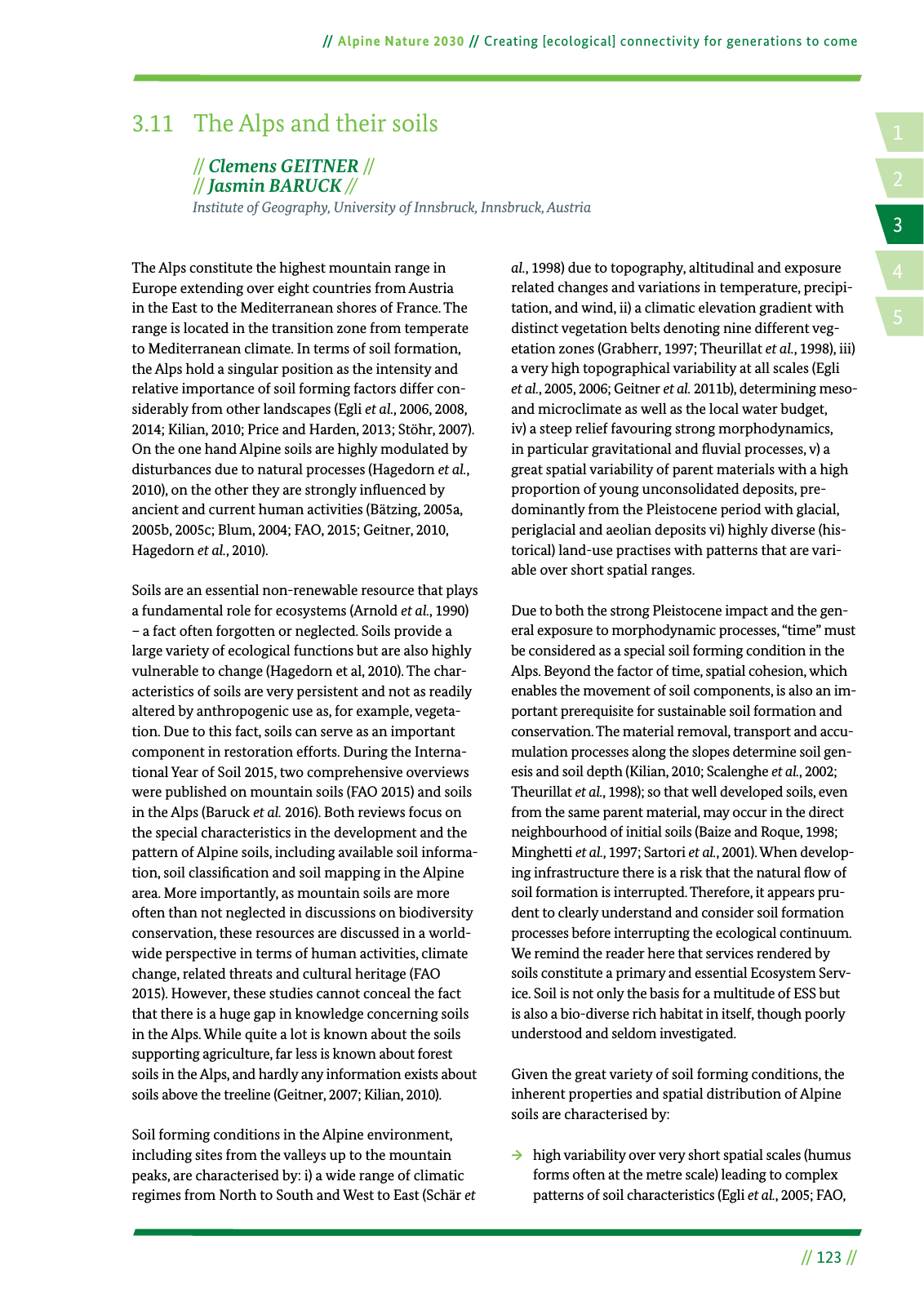14 2 5 3 Alpine Nature 2030 Creating ecological connectivity for generations to come 123 The Alps constitute the highest mountain range in Europe extending over eight countries from Austria in the East to the Mediterranean shores of France The range is located in the transition zone from temperate to Mediterranean climate In terms of soil formation the Alps hold a singular position as the intensity and relative importance of soil forming factors differ con siderably from other landscapes Egli et al 2006 2008 2014 Kilian 2010 Price and Harden 2013 Stöhr 2007 On the one hand Alpine soils are highly modulated by disturbances due to natural processes Hagedorn et al 2010 on the other they are strongly in uenced by ancient and current human activities Bätzing 2005a 2005b 2005c Blum 2004 FAO 2015 Geitner 2010 Hagedorn et al 2010 Soils are an essential non renewable resource that plays a fundamental role for ecosystems Arnold et al 1990 a fact often forgotten or neglected Soils provide a large variety of ecological functions but are also highly vulnerable to change Hagedorn et al 2010 The char acteristics of soils are very persistent and not as readily altered by anthropogenic use as for example vegeta tion Due to this fact soils can serve as an important component in restoration efforts During the Interna tional Year of Soil 2015 two comprehensive overviews were published on mountain soils FAO 2015 and soils in the Alps Baruck et al 2016 Both reviews focus on the special characteristics in the development and the pattern of Alpine soils including available soil informa tion soil classi cation and soil mapping in the Alpine area More importantly as mountain soils are more often than not neglected in discussions on biodiversity conservation these resources are discussed in a world wide perspective in terms of human activities climate change related threats and cultural heritage FAO 2015 However these studies cannot conceal the fact that there is a huge gap in knowledge concerning soils in the Alps While quite a lot is known about the soils supporting agriculture far less is known about forest soils in the Alps and hardly any information exists about soils above the treeline Geitner 2007 Kilian 2010 Soil forming conditions in the Alpine environment including sites from the valleys up to the mountain peaks are characterised by i a wide range of climatic regimes from North to South and West to East Schär et al 1998 due to topography altitudinal and exposure related changes and variations in temperature precipi tation and wind ii a climatic elevation gradient with distinct vegetation belts denoting nine different veg etation zones Grabherr 1997 Theurillat et al 1998 iii a very high topographical variability at all scales Egli et al 2005 2006 Geitner et al 2011b determining meso and microclimate as well as the local water budget iv a steep relief favouring strong morphodynamics in particular gravitational and uvial processes v a great spatial variability of parent materials with a high proportion of young unconsolidated deposits pre dominantly from the Pleistocene period with glacial periglacial and aeolian deposits vi highly diverse his torical land use practises with patterns that are vari able over short spatial ranges Due to both the strong Pleistocene impact and the gen eral exposure to morphodynamic processes time must be considered as a special soil forming condition in the Alps Beyond the factor of time spatial cohesion which enables the movement of soil components is also an im portant prerequisite for sustainable soil formation and conservation The material removal transport and accu mulation processes along the slopes determine soil gen esis and soil depth Kilian 2010 Scalenghe et al 2002 Theurillat et al 1998 so that well developed soils even from the same parent material may occur in the direct neighbourhood of initial soils Baize and Roque 1998 Minghetti et al 1997 Sartori et al 2001 When develop ing infrastructure there is a risk that the natural ow of soil formation is interrupted Therefore it appears pru dent to clearly understand and consider soil formation processes before interrupting the ecological continuum We remind the reader here that services rendered by soils constitute a primary and essential Ecosystem Serv ice Soil is not only the basis for a multitude of ESS but is also a bio diverse rich habitat in itself though poorly understood and seldom investigated Given the great variety of soil forming conditions the inherent properties and spatial distribution of Alpine soils are characterised by high variability over very short spatial scales humus forms often at the metre scale leading to complex patterns of soil characteristics Egli et al 2005 FAO Clemens GEITNER Jasmin BARUCK Institute of Geography University of Innsbruck Innsbruck Austria 3 11 The Alps and their soils

Hinweis: Dies ist eine maschinenlesbare No-Flash Ansicht.
Klicken Sie hier um zur Online-Version zu gelangen.
Klicken Sie hier um zur Online-Version zu gelangen.